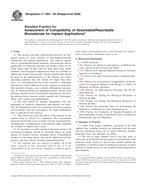Potrebujeme váš súhlas na využitie jednotlivých dát, aby sa vám okrem iného mohli ukazovať informácie týkajúce sa vašich záujmov. Súhlas udelíte kliknutím na tlačidlo „OK“.
ASTM F1983-99(2008)
Standard Practice for Assessment of Compatibility of Absorbable/Resorbable Biomaterials for Implant Applications
Automaticky preložený názov:
Štandardná prax pre posúdenie zlučiteľnosti vstrebateľných / vstrebateľný biomateriálov na prípravu implantátu aplikácie
NORMA vydaná dňa 1.8.2008
Informácie o norme:
Označenie normy: ASTM F1983-99(2008)
Poznámka: NEPLATNÁ
Dátum vydania normy: 1.8.2008
Kód tovaru: NS-52338
Počet strán: 5
Približná hmotnosť: 15 g (0.03 libier)
Krajina: Americká technická norma
Kategória: Technické normy ASTM
Anotácia textu normy ASTM F1983-99(2008) :
Keywords:
absorbables, biocompatibility, degradables, implantation, resorbables, Absorbable/resorbable biomaterials, Biocompatibility, Compatibility, Degradation--surgical devices/applications, Implantable surgical materials/applications, Resorbables, Tissue reactions, ICS Number Code 11.040.40 (Implants for surgery, prothetics and orthotics)
Doplňujúce informácie
| Significance and Use | ||||||||||||||||||
|
This practice is a guideline for a screening test for the evaluation of the local tissue response to materials that may be selected for implantation into the human body and which are expected to undergo degradation by absorption or resorption within three years. This practice is similar to that for studies on candidate materials that are not resorbable, such as those specified in Practices F 763, F 981, and F 1408; however, analysis of the host response must take into account the effect of degradation and degradation products on the inflammatory response at the local tissue site and on subsequent healing of the implantation site. The material to be tested should be in the final finished form as for intended use, including sterilization. Material/body ratios should be relevant to that of intended device use. Material surface area or mass to body mass ratios of 1X, 10X, and 50X if applicable, are recommended. Materials that are designed for use in devices with in situ polymerization shall be introduced in a manner such that in situ polymerization occurs. Testing of individual precursor components is not recommended. |
||||||||||||||||||
| 1. Scope | ||||||||||||||||||
|
1.1 This practice provides experimental protocols for biological assays of tissue reactions to absorbable/resorbable biomaterials for implant applications. This practice applies only to resorbable/absorbable materials with projected clinical applications in which the materials will reside in bone or soft tissue longer than 30 days and less than three years. Other standards with designated implantation times are available to address the shorter time periods. Careful consideration should be given to the appropriateness of this practice for slowly degrading materials that will remain for longer than three years. It is anticipated that the tissue response to degrading biomaterials will be different from the response to nonresorbable materials. In many cases, a chronic inflammatory response may be observed during the degradation phase, but the local histology should return to normal after degradation; therefore, the minimal tissue response usually equated with “biocompatibility” may require long implantations. 1.2 The time period for implant degradation will vary depending on chemical composition and implant size; therefore, the implantation times for examination of tissue response will be linked to the rate of resorption. No single implantation time is indicated in this practice. 1.3 These protocols assess the effects of the material on the animal tissue in which it is implanted. The experimental protocols do not fully assess systemic toxicity, carcinogenicity, teratogenicity, or mutagenicity of the material. Other standards are available to address these issues. 1.4 To maximize use of the animals in the study protocol, all toxicological findings should be recorded. There are some aspects of systemic toxicity, including effects of degradation products on the target organs, that can be addressed with this practice, and these effects should be documented fully. 1.5 This standard does not purport to address all of the safety concerns, if any, associated with its use. It is the responsibility of the user of this standard to establish appropriate safety and health practices and determine the applicability of regulatory limitations prior to use. |
||||||||||||||||||
| 2. Referenced Documents | ||||||||||||||||||
|




 Cookies
Cookies
